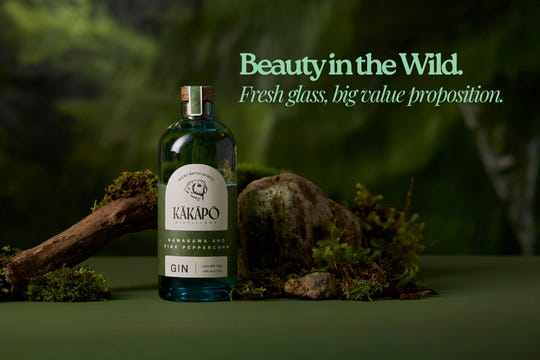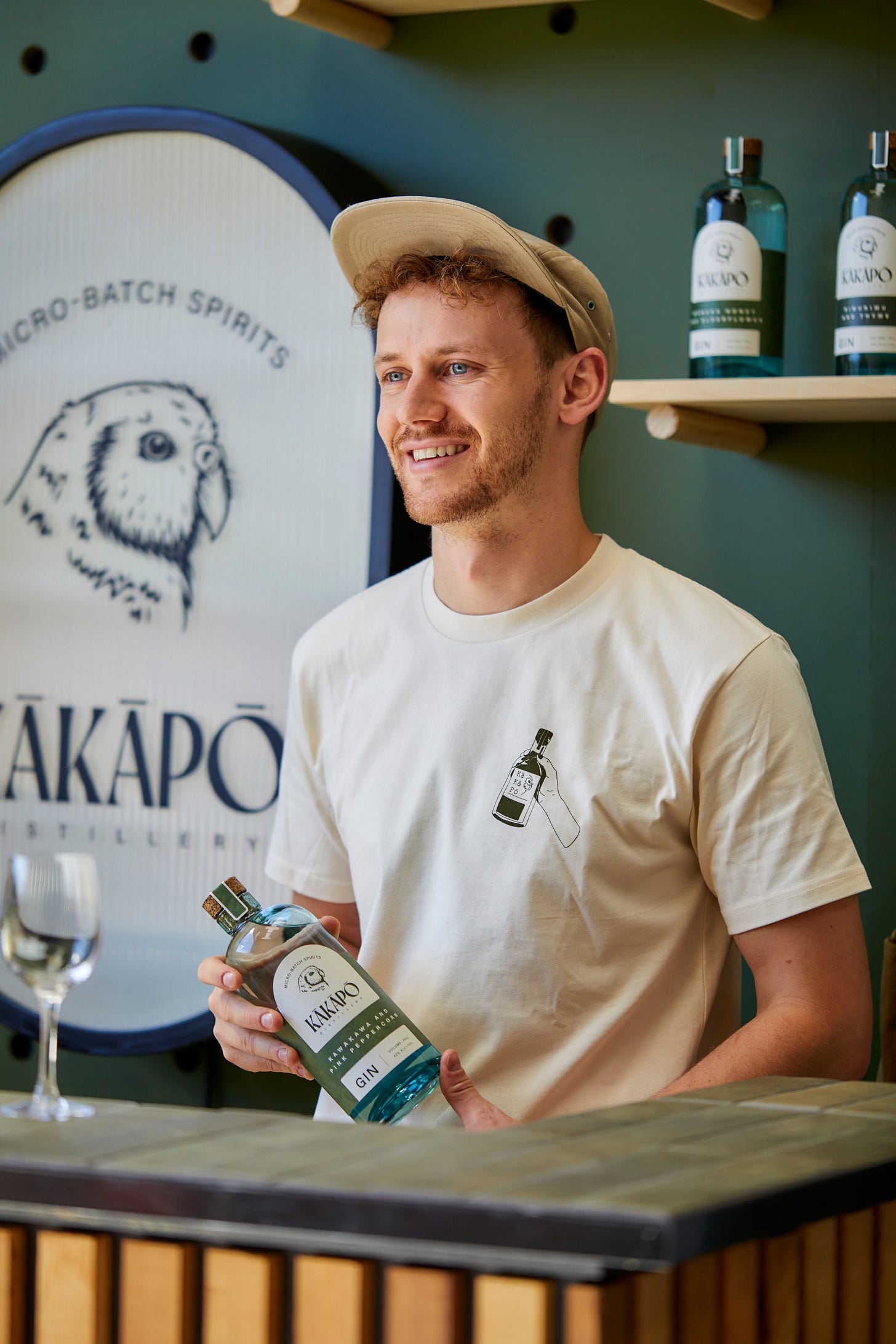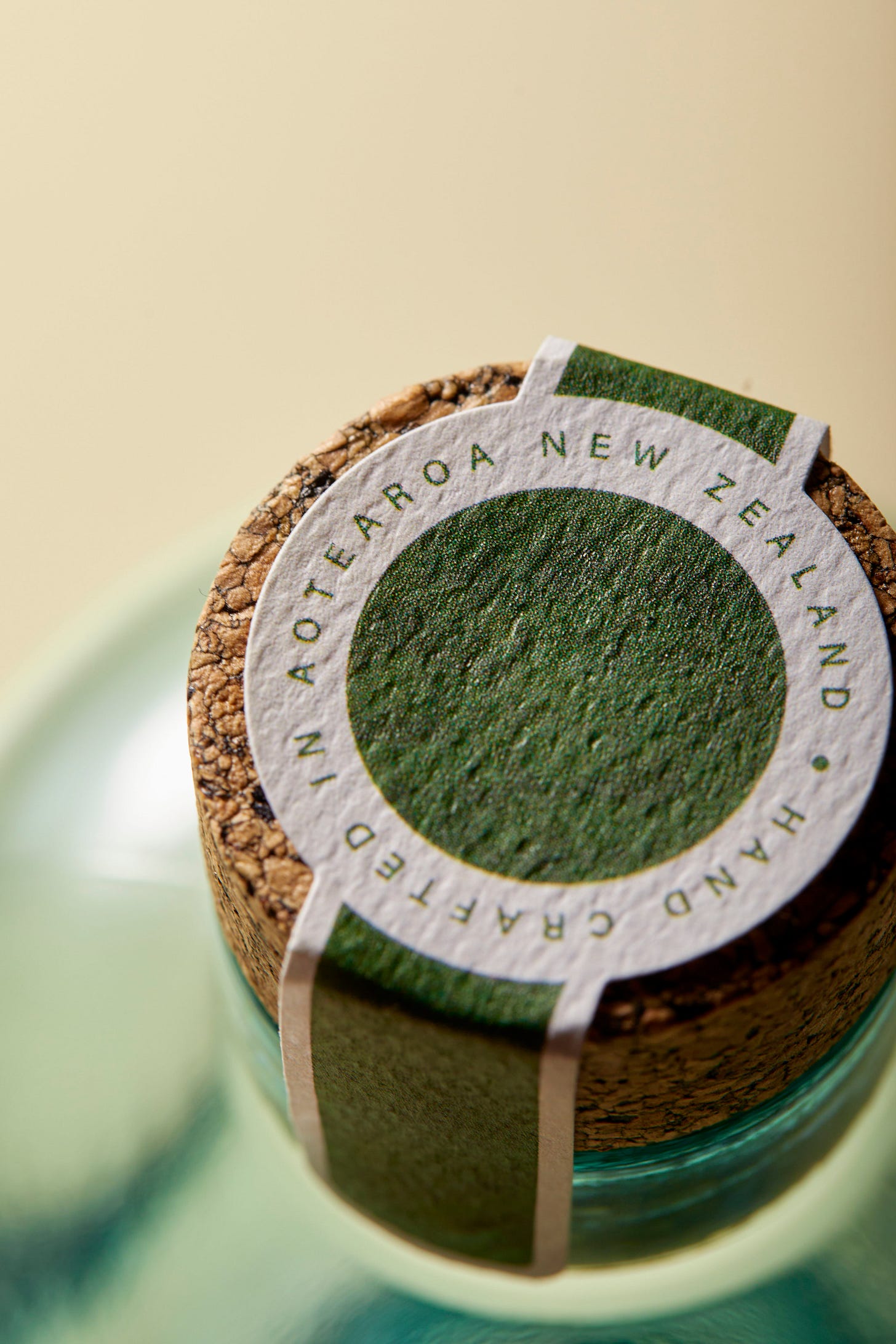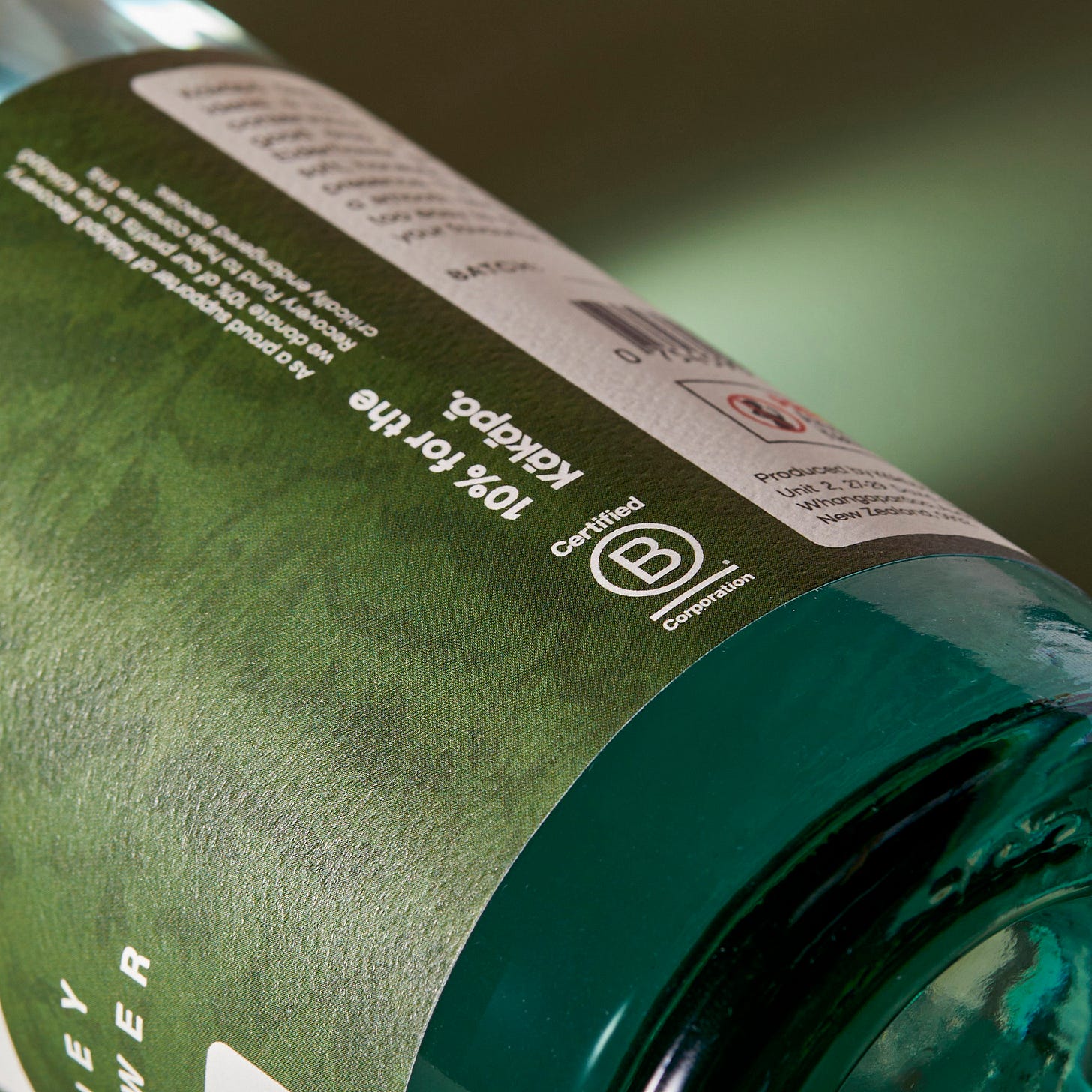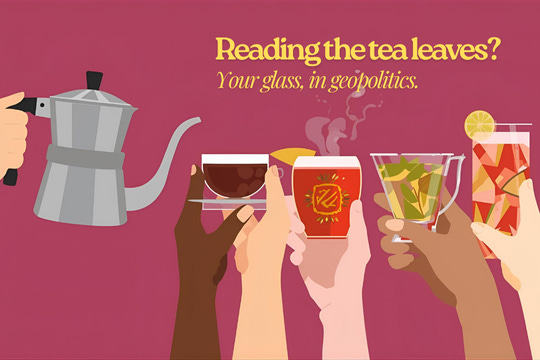The Wild Glass Gamble: How Kākāpō Distillery Bet on Beauty in a Brutal Market
The Auckland distillery is rolling out 100% recycled glass bottles in the middle of winter’s toughest trading conditions. It’s either brilliantly timed or completely mad—and the answer might be both.
There’s a particular kind of courage required to invest in premium packaging when everyone else is battening down the hatches. While distilleries across New Zealand are pulling back, trimming costs, and riding out what has been—let’s not mince words—a brutal winter for hospitality and premium spirits, Kākāpō Distillery is doing something quietly audacious. They’re launching new bottles. Beautiful ones. Made from 100% post-consumer recycled glass.
And they’re not passing the cost on to customers.
Let that sit for a moment. In an environment where every margin matters, this B Corp-certified distillery is absorbing the increased expense of more sustainable, more distinctive packaging because, as they put it, “sustainability shouldn’t be a barrier—consumers shouldn’t have to choose between quality and doing what’s right for the planet.”
It’s the kind of principled positioning that either builds unshakeable brand loyalty or gets you laughed out of a distributor meeting. But when you dig into the strategy behind Kākāpō’s refresh, you start to see the method behind what might initially look like madness.
The Timing Paradox
“Moving to a new bottle is a significant investment, especially in the current tough economic environment,” co-founder Conrad Morley acknowledges without flinching. So why now?
Because sometimes the only way forward is through.
This wasn’t impulsive. The search for 100% recycled glass bottles has been part of Kākāpō’s vision since inception—three to four years of navigating barriers, investigating suppliers, and waiting for the right moment. This year, several factors converged: a natural evolution point in the brand’s lifecycle, preparation for national expansion with new distribution partner The Liquor Locker, and the completion of nearly 12 months of research, brand refresh work, and field testing.
“There are so many unique, interesting products on the shelf now,” Morley notes. “We want to make sure that we are not getting lost.”
Here’s the commercial genius: In a compressed market, visibility becomes currency. Getting lost on the shelf isn’t just a marketing problem—it’s an existential threat. The new packaging isn’t despite the tough conditions; it’s because of them.
The Search for Wild Glass
Finding a supplier that ticked every box turned into an odyssey—one that reveals just how challenging sustainable choices remain for small producers.
The wishlist was deceptively simple: 100% post-consumer recycled glass, achievable minimum order quantities for a small producer, visual distinctiveness, and practical functionality. In reality? Nearly impossible to find all four in one package.
New Zealand suppliers couldn’t meet the requirements. Often, recycled glass is only available with custom bottles—prohibitively expensive for a brand at Kākāpō’s scale, with MOQs designed for multinationals rather than craft distilleries. Australia and China presented similar challenges: either the sustainability credentials weren’t there, or the volumes required were out of reach.
“We considered suppliers closer to home (e.g. NZ, Aus, China), but we either couldn’t meet the minimum order quantities or they didn’t align with our sustainability values,” Morley explains. “The supplier we have chosen is one of the very few groups in the world we are aware of that do ‘stock’ bottles at 100% PCR.”
That supplier is Estal, a European packaging solutions company that has become a benchmark in sustainable glass manufacturing. What makes Estal particularly attractive to craft producers isn’t just their recycled content—it’s their entire approach to production efficiency and accessibility.
Estal has rewritten the paradigms of industrial glass manufacturing through patented processes that allow unprecedented flexibility. Their furnaces work with the highest percentage of post-consumer recycled glass on the market—up to 100% PCR—and crucially, they accept all types of recovered glass. By embracing aesthetic imperfections as part of the organic beauty of the glass, they’ve reduced production waste from 25% down to 10%. Bottles that would traditionally be discarded for cosmetic defects are retained, maintaining structural soundness while celebrating the authentic, slightly irregular nature of truly recycled materials.
For Kākāpō, discovering that Estal wasn’t yet distributed in New Zealand created an unexpected advantage: “This was a good opportunity to still have something unique in a crowded shelf.”
But Wild Glass comes with a twist that perfectly aligns with Kākāpō’s values. The high recycled content means variability across every bottle—imperfections, bubbles, shifts in colour. For brands focused on manufactured perfection, this would be a quality control nightmare. For Kākāpō, it became the point.
“The imperfections, bubbles, and shifts in colour are some of the beautiful features of the bottles,” Morley says. “They show craftsmanship and tell the story of the recycled product in addition to the handcrafted, bespoke nature of our gin.”
It’s a masterclass in values-driven decision making: the variability in the glass mirrors the ethos of the liquid inside. Each bottle becomes a tangible reminder that sustainability and beauty aren’t opposing forces—they’re complementary. The choice of supplier wasn’t just about finding the most sustainable option; it was about finding the partner whose production philosophy aligned with Kākāpō’s own approach to craft.
And here’s where Kākāpō’s move becomes prescient: while consumer surveys consistently show environmental factors rank lower than price and quality in purchasing decisions—particularly in the current economic climate—McKinsey’s 2025 global research reveals that 51% of consumers still rank environmental impact as extremely or very important. More critically, younger consumers (Gen Z and millennials) and higher-income consumers show the highest willingness to pay more for sustainable packaging. Kākāpō isn’t chasing today’s mass market—they’re positioning for the consumers who will drive premium gin purchases tomorrow.
The Counter-Intuitive Market Reality
Here’s where Kākāpō’s strategy gets interesting against the backdrop of what’s actually happening in spirits consumption.
The US market—the world’s largest—saw overall spirits sales decline by 2.7% in early 2024, with super-premium spirits (the $100+ bottles) taking the hardest hit with nearly a 20% volume drop. The premiumization trend that fueled industry growth for years is stalling. Consumers are cutting back, trading down, choosing value spirits over ultra-premium expressions.
Except for one critical category: spirits that demonstrate clear quality and authenticity justifications for their premium positioning. In the spirits industry, packaging has become the primary brand differentiator, sustainability statement, and user experience driver. The brands winning market share aren’t just those with exceptional liquids—they’re the ones whose packaging tells a compelling story at first glance.
And while premiumisation as a whole is under pressure, younger consumers and higher-income consumers show the highest willingness to pay more for sustainable packaging. Kākāpō isn’t playing for the mass market retreat—they’re positioning for the premium segment that’s still growing: RTD cocktails (up 16.5%) and craft expressions that can justify their price through authentic sustainability commitments and distinctive shelf presence.
Industry analysts note that in tough economic times, spirits benefit from being “affordable luxuries”—consumers cutting back on big-ticket items still want to treat themselves. But the key word is justify. The packaging needs to validate the premium. Sustainability is transforming beverage packaging, moving beyond simple eco-friendly designs to more innovative and visually appealing solutions. Brands can no longer choose between premium aesthetics and sustainability credentials—the market increasingly demands both.
Function Meets Form
The field testing process revealed something crucial: what looks good in a design meeting doesn’t always work in reality. The bottle needed to pour well, fit a standard nip pourer, stand out on the shelf, and not consume excessive retail space. Balancing shelf presence with usability meant considering bartenders, retailers, and consumers simultaneously.
This attention to practical detail explains why Kākāpō’s Kawakawa and Pink Peppercorn Gin recently took home the Fever-Tree New Zealand Gin & Tonic Award at the NZ Spirits Awards. The liquid has always been carefully crafted—now the packaging finally reflects that same level of consideration.
“We are honoured to have received this award and were utterly surprised when we heard our name announced,” Morley reflects. The win arrived at exactly the right moment, providing validation and momentum as the new packaging rolls out. It’s proving particularly effective for off-premise sales and gift boxes—critical revenue streams in a tough trading environment.
The Metrics That Matter
The sustainability improvements are quantifiable and significant:
25% weight reduction (lowering transport carbon output)
0% to 100% post-consumer recycled glass
Cork closures now use a single industrial process with pressure instead of glue
Glass is infinitely recyclable but a finite resource. Achieving 100% recycled content isn’t just ticking a box—it’s a meaningful step in a broader commitment to circular thinking. The energy savings are substantial: recycled glass melts at lower temperatures than virgin materials, consuming 40% less energy during production and emitting fewer greenhouse gases.
But here’s where Morley gets refreshingly honest: “We are really only at the beginning of our carbon tracking journey.” He acknowledges that sustainability is broader than carbon accounting alone, incorporating environmental impact audits and waste measures to identify areas for improvement. It’s continuous improvement rather than performative perfection.
And that authenticity matters. The spirits industry has seen its share of greenwashing attempts, and consumers—particularly in premium segments—can smell inauthenticity from across the shop floor. Industry research shows that 86% of consumers under 45 are willing to pay more for sustainable packaging, and 57% are less likely to buy products in what they perceive as harmful packaging. But they also want transparency, not marketing spin.
The B Corp Commitment Beyond the Badge
Kākāpō gives 10% of profits to the Kākāpō Recovery programme. Their B Corp certification isn’t window dressing; it’s baked into decision-making at every level. The recycled glass bottles represent a visual manifestation of commitments that were always there but perhaps not immediately apparent to someone picking up a bottle for the first time.
Morley and the team are also exploring partnerships with local Auckland glass blowers to repurpose bottles returned through their return scheme, transforming them into products people want to keep rather than simply recycling them through standard channels. It’s circular thinking taken to its logical, creative conclusion.
The Long Game in a Short-Term World
With the move to a new manufacturing facility complete—yes, in the middle of winter, in the middle of an economic downturn—Kākāpō is playing a longer game than most. They’re looking at every material, every process, asking how it can be improved. Open days are planned to build community. Stirred Down Chat Season 2 is in development. International opportunities are being explored alongside the domestic expansion.
“We are still an incredibly small team, which allows us to be agile in our decision-making,” Morley notes. That agility has been critical for survival, but it’s the long-term vision that’s most striking in an industry where many are purely in survival mode.
The one-to-three-year vision? Establish a strong national presence, step into export markets, and potentially develop more creative, experimental expressions now that the core range of three distinctive gins is solidified.
What’s notable about Kākāpō’s approach is the controlled growth strategy: investment in brand differentiation rather than production scale, and a focus on building community and loyalty rather than chasing volume. The new packaging isn’t about rapid expansion—it’s about ensuring the growth they do achieve is sustainable in both senses of the word. When selecting a supplier, values alignment wasn’t just a nice-to-have; it was the primary filter. That philosophy—choosing partners whose approach to production mirrors your own commitment to quality and integrity—becomes increasingly valuable when market conditions tighten and every decision matters more.
The Motivation When It’s Hard
“Winter has been pretty tough,” Morley admits, “and this was heightened by the costs associated with moving facilities.”
So what keeps them going?
Partly the belief that conditions will improve. Partly the support of the craft community and wider industry. But mostly? Passion for the creative outlet itself.
And here’s where the strategy crystallises: the brand refresh, the recycled glass, the refusal to compromise on quality or sustainability—these aren’t separate initiatives. They’re integrated expressions of a distillery that understands its identity and is willing to invest in that identity even when (especially when) times are tough.
Because the brands that emerge stronger from difficult periods aren’t usually the ones who pulled back on everything that made them distinctive. They’re the ones who held the line on their principles and doubled down on what made them matter in the first place.
The Single Piece of Advice
If another small distillery was considering a similar move, what would Kākāpō tell them?
“It takes longer than you think.”
Finding suppliers that align with your values and meet your practical needs takes time. The brand refresh ripples outward—website design, boxes, labels, merch. Field testing is essential because assumptions don’t always survive contact with reality.
But perhaps the unspoken lesson is more fundamental: when selecting suppliers and making packaging decisions, values alignment should be the first filter, not the last consideration. Kākāpō could have chosen cheaper options, closer suppliers, or bottles that were “good enough” on sustainability metrics. Instead, they held out for a partner whose production philosophy genuinely mirrored their own commitment to quality, authenticity, and environmental responsibility. That alignment becomes the foundation for everything else—the storytelling, the brand credibility, the consumer trust.
The challenge for craft producers isn’t just finding sustainable packaging; it’s finding sustainable packaging at a scale and price point that makes sense for small-batch production. The fact that Kākāpō had to search globally to find bottles that met both their sustainability requirements and their MOQ constraints reveals an infrastructure gap that the industry still needs to address. “We would love to see New Zealand suppliers producing 100% recycled glass with smaller minimum order quantities to make this more of an accessible solution for smaller distilleries like us,” Morley notes.
Until that infrastructure exists, craft distilleries face an uncomfortable trade-off: compromise on sustainability values, or accept the complexity and cost of sourcing from overseas suppliers who can meet both criteria.
The spirits packaging market is projected to grow from $4.67 billion in 2021 to over $8.69 billion by 2033, driven largely by sustainability demands and the need for distinctive shelf presence. But that growth will be concentrated among brands that made the hard choices early—the ones who invested in premium, sustainable packaging even when market conditions suggested pulling back, and who chose suppliers based on values alignment rather than convenience.
Kākāpō Distillery is making their bet right now, with Wild Glass bottles that carry the beautiful imperfections of recycled materials and the weight of carefully considered choices. Whether it pays off commercially remains to be seen. But as brand strategy in brutal conditions goes, it’s certainly more interesting than playing it safe.
And in a market where getting lost on the shelf is the real risk, interesting might be the smartest play of all.
Kākāpō Distillery’s refreshed packaging is rolling out now through The Liquor Locker nationally. New look packaging is available exclusively in Liquorland til November 1, 2025 and then in all good liquor stores. The distillery’s new manufacturing facility in Auckland will host open days in coming months—details TBC.
Interested in a deeper dive? Check out the latest Full Pour Feature.
Your Drink Is Political: The Liquid Power Map Is Being Redrawn
Here’s the question: When you dismiss a drink because it’s unfamiliar—too smoky, too strong, too foreign—are you exercising taste, or enforcing prejudice?



